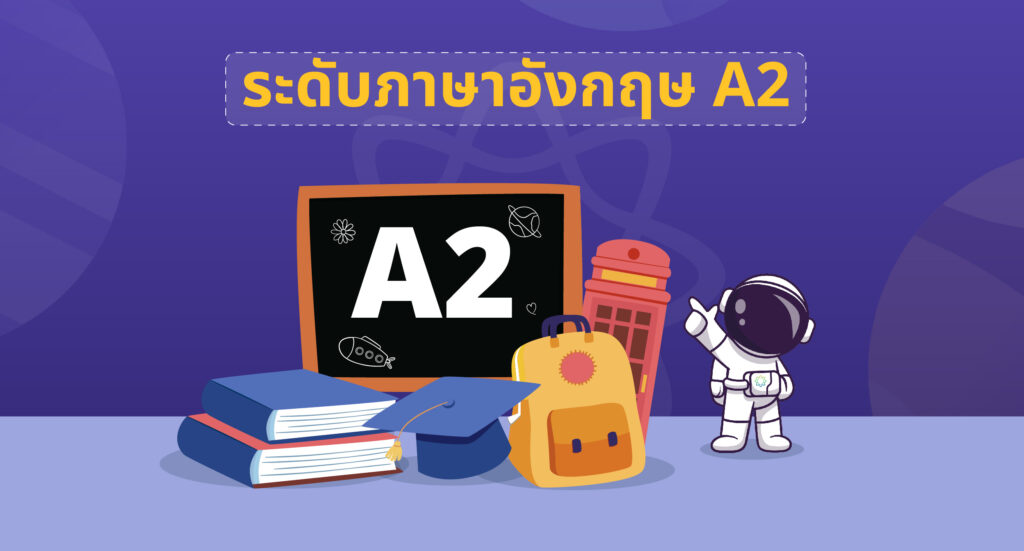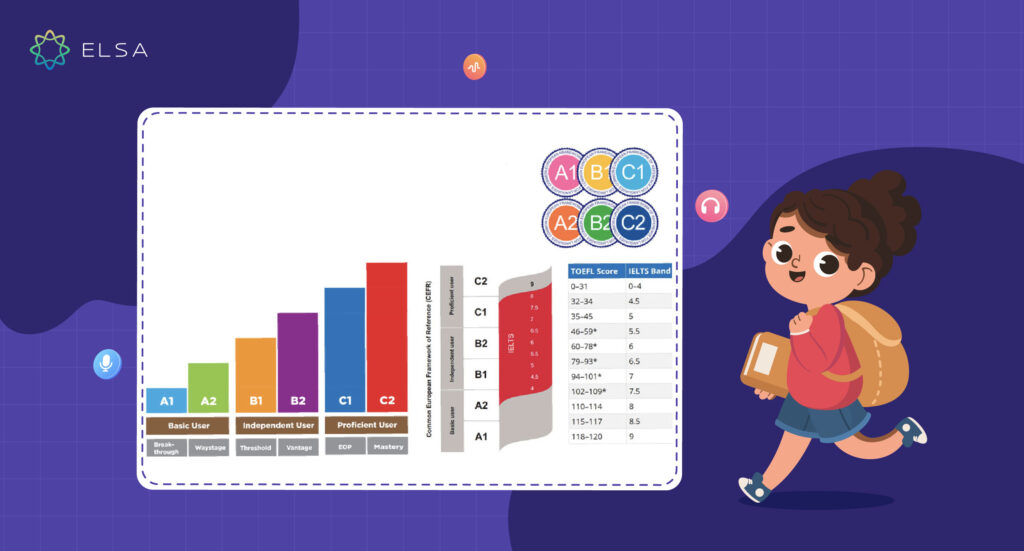
In English learning, proficiency is typically measured across six levels. These levels help assess how well someone can understand and use the language in real-life situations. With ELSA Speak, you can explore all six CEFR levels — complete with clear definitions and quick assessments — to find out where you are and how to move forward. Curious about your English level? Let’s dive into the six CEFR levels and see how ELSA can help you improve, step by step!
What Are English Proficiency Levels?

English proficiency refers to the ability to use English effectively for communication, work, and everyday life.
There are four key language skills in English: listening, speaking, reading, and writing. To become fluent, learners need to develop all four skills in a balanced and consistent way. Mastering these core areas helps build confidence and ensures that learners can use English naturally in both academic and real-world situations.
Why Should You Take an English Placement Test?
An English placement test assesses your skills in speaking, listening, reading, and writing to determine your current level of proficiency. Knowing your level helps you understand your strengths and areas for improvement. Once your current ability is identified, you can create a learning plan that suits your needs — making it easier to progress to higher levels and achieve your English goals more effectively.
What Are the CEFR English Levels?
CEFR Level A1 – Beginner

- Level A1 corresponds to a basic user of English who can understand and use very simple, everyday expressions and phrases. According to the CEFR, a learner at A1 level is able to:
- Understand and use familiar everyday expressions and very basic phrases aimed at meeting simple needs.
- Introduce themselves and others, and ask and answer questions about personal details — such as where they live, things they have, and people they know.
- Interact in a simple way, provided the other person speaks slowly and clearly and is willing to help.
CEFR Level A2 – Elementary

Level A2 corresponds to learners who can understand frequently used expressions and communicate in simple, routine situations.
According to the CEFR, a learner at A2 level is able to:
- Understand sentences and commonly used expressions related to areas of immediate personal relevance (e.g. personal and family information, shopping, favourite places, work, etc.). Communicate in simple and routine tasks requiring a direct exchange of information on familiar topics. Use basic vocabulary to describe aspects of their past, their surroundings, and matters related to their immediate needs.
- Communicate in simple and routine tasks requiring a direct exchange of information on familiar topics.
- Use basic vocabulary to describe aspects of their past, their surroundings, and matters related to their immediate needs.
CEFR Level B1 – Intermediate

Level B1 corresponds to learners who can understand and produce text on familiar topics and express opinions or descriptions.
According to the CEFR, a learner at B1 level is able to:
- Understand the main points of clear standard input on familiar topics, whether related to work, study, or leisure.
- Handle most situations likely to arise when travelling in an area where English is spoken.
- Create simple connected text on topics that are familiar or of personal interest.
- Describe experiences, events, dreams, and ambitions, as well as explain opinions or plans in a straightforward way.
CEFR Level B2 – Upper Intermediate
Level B2 corresponds to learners who can produce clear, detailed text and communicate fluently and naturally in both familiar and new contexts.
According to the CEFR, a learner at B2 level is able to:
- Understand the main points of complex texts on both concrete and abstract topics, including technical discussions in their field of expertise.
- Interact with fluency and spontaneity, allowing for regular interaction with native speakers without strain for either party.
- Produce clear, detailed text on a wide range of subjects related to their interests. They can explain viewpoints on a current issue, giving the advantages and disadvantages of different options.
CEFR Level C1 – Advanced

Level C1 corresponds to learners who can express themselves fluently and naturally, using the language with flexibility and effectiveness for all purposes.
According to the CEFR, a learner at C1 level is able to:
- Understand longer and more complex texts and grasp implicit meanings.
- Express their opinions fluently and naturally, without having to search for the right words.
- Use English effectively and appropriately in social, academic, and professional contexts. Create clear, well-structured, and detailed text on complex subjects, demonstrating the ability to organise ideas, use connectors, and link thoughts within the text.
CEFR Level C2 – Proficient
Level C2 corresponds to learners who are highly proficient in English, capable of understanding and communicating easily on any subject, with an ability to distinguish between similar meanings.
- Understand virtually everything they hear or read with ease.
- Summarise information and arguments from various sources, both spoken and written, in a clear and concise manner.
- Communicate naturally, fluently, and accurately, even in more complex and abstract situations, and recognise subtle differences in meaning.
Meaning of the Six English Proficiency Levels
- Beginner Level: Unable to communicate in English.
- Elementary Level: Can understand and ask simple questions using basic sentences, and can understand conversation if spoken slowly.
- Pre-Intermediate Level: Can understand and exchange information in everyday situations.
- Intermediate Level: Can speak, write, and understand the main points of general texts on familiar or unfamiliar topics.
- Upper-Intermediate Level: Can use English confidently in a wide range of educational and work-related situations, although there may be some limitations in terms of detail and accuracy.
- Proficient Level: Very high proficiency in English. Can use both spoken and written English with accuracy and fluency on any topic, including understanding more complex texts.
English Proficiency Test

English Proficiency Test Structure
Section 1: Grammar
The Grammar test consists of 100 multiple-choice questions, with five options for each question. The total time allocated for this section is 40 minutes.
The questions in this section are mostly short and focus on selecting the most appropriate answer, identifying incorrect answers, choosing the right word, and correcting grammatical mistakes.
Example:
Q: Which sentence is incorrect?
A: Two men are talking.
- The children are playing.
- That person speak Japanese.
- The womans are at restaurant.
This section requires candidates with at least an intermediate level of grammar knowledge, and attention to detail is crucial to spot hidden errors.
Section 2: Listening
The Listening test consists of 12 multiple-choice questions, with five options for each question. The total time allocated for this section is 20 minutes.
Candidates will listen to a 3-minute audio file and answer 12 questions within 20 minutes. The audio may describe a room, a map, or tell a story about a character's life. Candidates need to pay close attention and grasp the overall context (e.g., when listening to a description of a picture) while noting specific details.
The listening section may feature accents from American, Australian, and British English, reflecting the diversity of accents in an international work environment.
Section 3: Reading
The Reading test consists of 9-12 multiple-choice questions, with five options for each question. The total time allocated for this section is 20 minutes.
The reading passage will consist of 5-6 paragraphs (no more than 1000 words). The content is often academic and may cover topics such as business, economics, or history, alongside everyday life stories. This section is weighted quite heavily in the test, so practising this part as much as possible is recommended.
Section 4: Writing
The Writing test consists of one question, with a total time of 15 minutes. The main topics are usually one or two of the following types:
1. Write a Sentence Based on a Picture: This assesses vocabulary and grammar used to describe the picture appropriately.
2. Write an Opinion Essay: In addition to evaluating vocabulary and grammar, this task also assesses the organisation and structure of the essay.
Section 5: Speaking
The Speaking test consists of one question, with a total time of 5 minutes.
The questions in this section focus on the following:
- Describe a Picture: This assesses pronunciation, stress, intonation, grammar, vocabulary, and relevance to the provided image.
- Respond to Questions: Candidates will answer questions.
- Respond to Questions Using Information Provided: Candidates will answer questions based on the given information.
- Propose a Solution: Candidates will suggest solutions to a problem.
- Express an Opinion: Candidates will share their opinions on a given topic.
This section will assess your pronunciation, stress, intonation, vocabulary, grammar, and the relevance of the content to the questions.
In this section, you will have the opportunity to speak only once, and you will respond through a microphone throughout the test. Therefore, it is important to speak clearly and be careful when pressing the record button to ensure your answers are recorded correctly.

English Proficiency Test Score Levels
A1: Breakthrough in English – Beginner Level: 0-199 Points
The A1 level is the first stage in the Common European Framework of Reference for Languages (CEFR). You will receive the A1 level if your test score falls between 0 and 199 points. The A1 level is sufficient for very basic communication.
A2: Waystage in English – Elementary Level: 200-299 Points
The A2 level is the second stage in the CEFR. You will achieve an A2 level if your score falls between 200 and 299 points. At this level, learners will have a basic understanding of English and be able to communicate their fundamental needs.
B1: Threshold in English – Intermediate Level: 300-399 Points
The B1 level is the third stage in the CEFR. You will receive a B1 level if your score is between 300 and 399 points. At this level, learners have more than a basic understanding but may still struggle with using English for all work or academic tasks.
The B1 level is sufficient for communication on familiar topics with English speakers. In a work setting, individuals with a B1 level can read simple reports on familiar topics and write basic emails about issues within their field. However, B1 is still not enough for working entirely in English.
B2: Vantage in English – Upper-Intermediate Level: 400-499 Points
The B2 level is the fourth stage in the CEFR. You will achieve the B2 level if your score falls between 400 and 499 points. At this level, learners can use English independently in a variety of learning and work environments, although there may still be limitations in depth and precision.
C1: Effective Operational Proficiency in English – Advanced Level: 500-599 Points
The C1 level is the fifth stage in the CEFR. You will receive a C1 level if your score falls between 500 and 599 points. At this level, learners can use English fluently and precisely on a wide range of topics and in almost all situations without needing preparation.
C2: Mastery in English – Proficient Level: 600-690 Points
The C2 level is the sixth and final stage in the CEFR. You will receive a C2 level if your score falls between 600 and 690 points. The C2 level is essentially equivalent to a native speaker's proficiency, as learners can read and write any type of document on any topic, expressing ideas and emotions with subtlety. They can fully participate in all learning or work environments.
Score Level Conversion:
| EIC | IELTS | TOEFL Paper | TOEFL CBT | TOEFL IBT | Cambridge Exam | CEFR |
| 0-250 | 0 – 1.0 | 0 – 310 | 0 – 30 | 0 – 8 | ||
| 1.0 – 1.5 | 310 – 343 | 33 – 30 | 9 – 18 | A1 | ||
| 255 – 400 | 3.5 | 397 – 433 | 93 – 120 | 30- 40 | KET (IELTS 3.0) | A2 |
| PET (IELTS 3.5) | B1 (IELTS 3.5) | |||||
| 405- 600 | 4.0 | 437 – 473 | 123 – 150 | 41 – 52 | PET | B1 |
| 4.5 – 5.0 | 477 – 510 | 153 – 180 | 53 – 64 | PET (IELTS 4.5) | B1 (IELTS 4.5) | |
| PEC (IELTS 5.0) | B2 (IELTS 5.0) | |||||
| 605 – 780 | 5.5 – 6.0 | 513 – 547 | 183 – 210 | 65 – 78 | PCE | B2 |
| 6.5 – 7.0 | 550 – 587 | 213 – 240 | 79 – 95 | CAE | C1 | |
| 785 – 990 | 7.5 – 9.0 | 590 – 677 | 243 – 300 | 96 – 120 | CPE | C2 |
| TOP SCORE | TOP SCORE | TOP SCORE | TOP SCORE | TOP SCORE | TOP SCORE | TOP LEVEL |
| 990 | 9 | 677 | 300 | 120 | 100 | C2 |

Frequently Asked Questions
What is the Intermediate English level?
The Intermediate English level corresponds to levels B1 and B2 in the Common European Framework of Reference for Languages (CEFR).
How many levels are there in the English proficiency test?
The CEFR divides English proficiency into 6 levels, grouped into 3 categories:
- Basic (A1 – A2)
- Independent (B1 – B2)
- Proficient (C1 – C2)
What is the C2 level?
The C2 level is the sixth and final level in the CEFR. It is considered the level of "bilingual proficiency."
What is the Basic level?
The Basic level corresponds to A1. Those at the Basic level can understand and use familiar expressions in everyday situations.
Source: ELSA Speak


